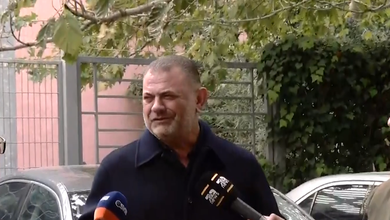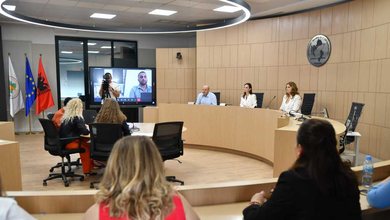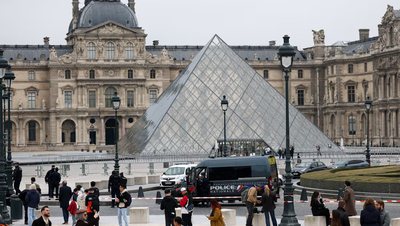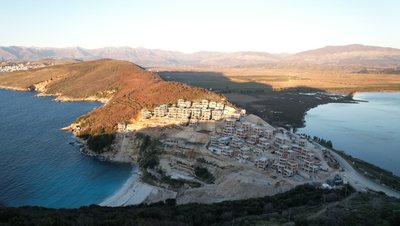Journalist Geri Emiri has won today the European Union's First Prize for Investigative Journalism with his article about the resort built near the Bay of Manastir, listing all the damage caused to the archaeological potential of Butrint Park.
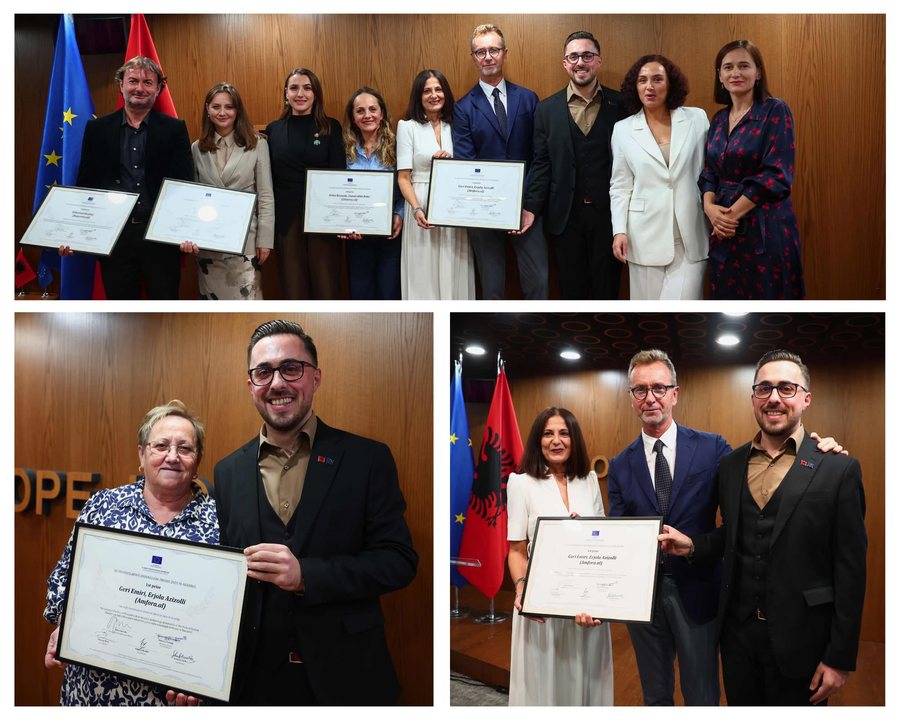
Full text:
The construction of a resort permanently transformed the Bay of Manastir, which divides the Ionian Sea from Lake Butrint, and in turn destroyed the archaeological potential of the area, including a 2010 discovery. The company did not respect archaeological monitoring and was found in violation by a UNESCO-ICOMOS assessment. Meanwhile, cultural authorities censored documents and changed alibis several times.
In a narrow strip of land that separates Lake Butrint from the Ionian Sea, lies a sea bay that preserves extraordinary traces of the flourishing of life throughout antiquity and the Middle Ages.
“Monastery Bay” took its name from the Monastery of Saint George, which has been built there since the 17th century and stands at the tip of the Ksamil Peninsula. Archaeological finds nearby are much earlier, starting from the 4th-3rd centuries BC.
Until 2022, there was little construction intervention in the area, mainly by tourist structures, but the situation was reversed after the Albanian government eroded the protected area of the Butrint National Park and paved the way for construction projects.
At a faster pace than the decisions of the Albanian state, the “Monastery Resort” project received immediate support as a strategic investment, to build a tourist village in the almost untouched bay of Manastir.
The project by the company “ALB-STAR” is expected to be completed next year and is worth 28 million euros, radically transforming the area, through the construction of villas from 2 to 4 floors, including a hotel, service areas and underground parking.
“Escape to your own private paradise,” the company promises buyers on social media “Instagram”. The project combines Greek style with Italian architecture, taking as a model Positano, a cliffside village on the Amalfi Coast, in southern Italy.
The Monastery of Saint George is located at the top of the Ksamil Peninsula.
Although it highlights the potential of the archaeological monuments and the nature of the area, the project seems to have become a haven for non-implementation of the law on culture and UNESCO regulations.
During a 2-year investigation, Amfora discovered that the project, which is being developed on an area of 53,467 m2, affects one of the areas with high archaeological potential of the Butrint National Park and a chain of institutions have failed to monitor the works.
Although in 2010 new ancient structures were accidentally discovered, the resort project continued by destroying one of the discoveries that was initially suspected to be a Late Antiquity fortification tower, as well as by carrying out underground works without archaeological monitoring.
The National Institute of Cultural Heritage (IKTK) censored the documents it had and for almost 1 year changed its alibi several times, exposing fictitious procedures and procedures carried out in violation of the legal provisions for IKTK itself and the scientific council that operates under it.
“On that hill, the Dema Wall was first built, Albanian archaeology, in connection with the writings of various archaeologists, especially Budina and others after him in various articles, places it in the 4th-3rd century BC”, said researcher Halil Shabani about the archaeological potential of the area, starting from the “Monastery Hill”.
The UNESCO-ICOMOS Permanent Mission found that after removing 600 hectares from the Protected Area, the way is paved for the construction of the resort, which however has encroached and was built within the “Buffer Zone” because the procedures of the World Heritage Convention for boundary modifications were not followed.
“There is now a situation where the National Park and the buffer zone of the World Heritage property are changing and the buffer zone now includes a large residential tourist resort,” found the report that Amfora read.
The sterile report of the archaeological survey
The Albanian government changed the zoning of the Protected Areas in Albania in the face of a flood of criticism, creating many coveted pockets on the Albanian coast for construction that have begun after the approval of the new boundaries.
The Council of Ministers' Decision No. 59, dated January 26, 2022, removed 802 hectares from the Butrint National Park's Protected Area, shrinking it from 9,424 hectares to 8,622 hectares. That is, 202 hectares more than what the UNESCO-ICOMOS report found in October 2022.
Before the zoning changes to the Protected Areas entered into force, in February 2022, the Strategic Investments Commission approved, through decision no. 8/6, dated December 2, 2021, the status of strategic investor "with assisted procedure" for the company "ALB STAR" sh.pk.
The Commission, led by Prime Minister Edi Rama, assessed that the project met all the legal criteria to benefit from the special status of "strategic investor", which includes a series of fiscal incentives and infrastructure support. Although the company “ALB STAR” sh.pk applied and obtained this special status, a shadow company is managing this entire investment.
The entity “MANASTIRI RESORT” was created even before the final decision of the Albanian government was made. On November 16, 2021, the company was founded, which is dealing with the construction and management starting from the villas, to the hotel and the beach.
Based on the extracts of the National Business Center, initially the shareholders of the company were two sub-companies, “FINMAN”, which held 50% of the shares and is controlled by the Ismailaj Family, also owners of “ALB STAR” sh.pk, and the entity “ANDI” sh.pk, which held 50% of the shares and is controlled by the Gjiknuri Family – shares which it ultimately sold to the partner “FINMAN”, on November 1, 2022.
The documentation that accompanies each investment in areas with archaeological potential goes through several filters and controls, before and during the launch of investments in the field. As in any similar case, the project went through the National Council of Cultural Heritage, which approved the archaeological survey report, which is composed of experts and representatives of cultural institutions.
Amfora requested the National Institute of Cultural Heritage (IKTK) to provide the archaeological survey report prepared for this project, which is preliminary and presents the situation on the ground. IKTK refused to submit the report in violation of the Law on the Right to Information, changing its position several times over about 10 months.
In the report that Amfora later found, it turns out that it provides an analysis of the surface of the site and the archaeological potential outside it, but without mentioning the discovery of the circular structure in 2010.
The document turns out to have been prepared by archaeologist Iris Pojani, a licensed expert for archaeological services, simultaneously head of the Department of Archaeology and Cultural Heritage, at the University of Tirana.
Although it took almost a year for the Albanian government to announce that it would change the boundary of the Protected Areas, the company had commissioned this report in March 2021, before the proposal was submitted for evaluation by the Strategic Investment Committee.
“The construction area including above-ground and underground spaces will be around 25,000 m² of construction, while the areas where the landscape will be intervened, including alleys, paths and stairs, reach 12,000 m²,” the report noted.
Pojani also refers to the 2010 Annual Report of the former Archaeological Service Agency, mentioning only the incidental findings that emerged before the reconstruction of the road at that time and explaining that they are not affected by the “Manastiri Resort” project.
But in the same official report that Pojani cited, it turns out that there is also data for another archaeological discovery in the same area. The report of the time identified it as a circular structure, suspected of being a watchtower belonging to Late Antiquity, a possible second phase of the Dema Wall. This discovery was on the trail of the resort and was flattened during the works.
David Dulaj is a resident of the area who confessed to Amfora that he worked in 2010 as a worker for moving soil during the archaeological excavation and showed that before the 90s they had placed a tombstone near the structure.
"Then they opened it again and the small, beautiful structure came out. Now it is not visible, it has been destroyed," Dulaj confessed about the discovery of 2010, after specifying several times that the discovery site had been intervened several times during communism.
However, Pojan's report, commissioned by the company that is building the resort, only lists archaeological data for the area outside the project and does not provide any elements or suggestions for the circular structure that was discovered in 2010 and that is today within the resort's footprint.
The report highlighted that it is planned to build an underground parking lot with 22 parking spaces and another even larger one, with 38 parking spaces. However, the recommendations at the end of the report do not provide any guidance on conducting archaeological surveys for these underground works.
In areas with high archaeological potential, in areas where underground works are carried out, it is recommended to conduct surveys, which are preliminary soil checks, to assess whether the foundations or excavation works affect archaeological structures.
Pojan's report was approved at the meeting of the National Council for Material Cultural Heritage (KKTKM), through decision number 271, dated June 8, 2021. But the entire process by the "ALB-STAR" company seems to have been a farce, with the aim of completing the preliminary documentation for obtaining the "strategic investor" status.
The KKTKM tasked the company to conclude a 3-party agreement with licensed entities in the field of archaeology in advance, to monitor the works every day. The council did not see fit to require archaeological surveys for the project that affects a high-risk area. On the other hand, the company continued the works without any monitoring, contrary to the KKTKM decision.
Amfora monitored the resort's works since the summer of 2022 and they initially continued with the removal of soil volumes, reducing the height of the hill and carrying out massive excavation works.
The resort's works moved unmonitored soils. Photo on 28.07.2022, by Media Amfora
According to the IKTK's response in the summer of 2023, the entity had not yet concluded an agreement for archaeological monitoring, continuing the works that affect the underground without any control, contrary to the decision of the scientific council.
“The National Institute of Cultural Heritage has not administered any kind of notification on the start of works or incidental findings in relation to the project in question”, explained IKTK, among other things.
But the company “ALB STAR”, which violated any obligation towards the cultural authorities, was previously provided by them with a license, authorizing it to intervene in material cultural property. Far from respecting the existing heritage, the project documents that Amfora read also foresee the construction of a chapel on the rocky coast of Manastir.
The companies “ALB STAR”, “MANASTIRI RESORT” and the archeology Iris Pojani, did not respond to requests for comment, sent by Amfora to know their position.
The UNESCO-ICOMOS permanent mission stated that, “The Mission was not informed whether this procedure was followed in the case of Manastir Resort or not”, regarding the following of procedures for the protection of archeology and requested their full implementation.
“However, the role played by the Ministry of Culture in the specific case of the Manastir Resort remains very unclear for the mission,” added the report prepared in October 2022.
The Albanian Ornithological Society (AOS), in a response to the Amfora Media, highlighted that these interventions bring many negative impacts on habitats, including changes and violations of flora and fauna.
“Resort on the borders/touches of the KP [National Park], in the area called Manastir Beach, with a modified, deforested and built-up area (building and infrastructure) of about 5.2 ha,” the AOS highlighted for the Manastir Bay project.
"It is also worth noting that the area removed by decision of the Council of Ministers in January 2022 is significantly larger than that recommended by the IMP and, moreover, was followed by a construction permit dated February 11, 2022, granted by the National Council of Territory for the Monastery Resort. This is a major urbanization project, although developed as a tourist resort," the UNESCO and ICOMO report found.
In addition to irreparable damage and transformations to the heritage, according to experts, these projects are also jeopardizing the prospects of these natural-cultural assets for inclusion in the protected areas of the European Union.
"It is important to emphasize that these actions 'undermine' the possibility that the Butrint area will be declared in the future as an Area of Importance for the European Community and a Natura 2000 Area, an obligation for Albania before becoming part of the European Community," the Ornithological Society of Albania analyzed.
Changing the alibi several times
The National Institute of Cultural Heritage (IKTK) has maintained different positions over the course of 10 months, from claims about the possession or not of the project documents, to changing the version about the archaeological discovery of 2010.
Amfora asked IKTK for the minutes of the scientific meetings of 2010, where the circular structure was discovered, and for the meeting of 2021, where the “Manastiri Resort” project was approved. Initially, IKTK refused to provide this data, explaining that the discussions contained personal data, claims that were later dismissed by the Commissioner for the Right to Information.
Contrary to its decision, number 51, taken on November 8, 2023, IKTK refused to provide the public documents. After Amfora's continuous requests, it changed its position and from the assertion that it had the documents, but was not providing them due to personal data, it indicated that it did not have them because they did not exist.
"From the research at the Technical Archive and the Technical Secretariat of the National Institute of Heritage, it results that there are no minutes for the above-mentioned decisions," IKTK responded.
Ironically, both meetings, in 2010 and 2021 for the same area, were held in violation of legal guidelines. Referring to only two Decisions of the Council of Ministers, number 364, dated May 29, 2019 and number 208, dated April 10, 2019, it is determined, among other things, that, “The decision is reflected in the minutes of the meeting”, requiring that not only the discussions during the meeting, but also the decision be reflected in the minutes.
The course changed 360 degrees for the other document, the archaeological survey report, prepared for the private company by archeologist Iris Pojani.
Although it was supposed to archive it in hard copy, IKTK was “robbed” of the document in the only form it had, electronic, after initially claiming that it was not providing it due to copyright.
Almost 10 months after not providing the report and directing that it be taken to the private entity that prepared it, the IKTK responded that:
"In the e-permit system where applications are uploaded, which are reviewed by the National Council for Material Cultural Heritage (KKTKM), it turns out that after the cyberattack, in mid-July 2022, there is no data on the applications uploaded earlier, specifically including the 'Archaeological Observation Report', approved by Decision No. 271, dated 08.06.2021 of the KKTKM".
The same thing happened with the archaeological discovery of 2010, where after much correspondence, Amfora was introduced to a new position on the typology of the structure itself.
The 2010 Annual Report of the former Archaeological Service Agency (ASHA) features on its back cover a photo of a circular structure, which has now been destroyed by the resort’s works.
During the works that began for the improvement of the road connecting Çuka with Butrint in 2010, the works were stopped as soon as archaeological structures were encountered at the intersection to the Monastery of Saint George. The finds and evidence were numerous and ASHA itself was invested in documenting a circular structure and the ancient walls nearby.
"The building presents a circular shape, almost regular. It consists of two rows of walls, the outer and the inner. The outer wall is wider than the inner one, its width is 0.90 m and the maximum height up to the excavated level is about 0.50 m," writes the Archaeological Rescue Report, which was prepared by ASHA in 2010.
Nearby, ancient walls of a very high quality construction level have been identified since 1963, with the aim of protecting and dividing the territory of Butrint in the south from the territory of the Hellenistic city of Phoenicia in the north.
They date back to at least 232 BC and several phases of their consolidation have been identified. The new structures that emerged from the road works also raised questions about the later phases of the renovation.
A 2012 scientific article by British archaeologist Richard Hodges and Albanian colleague Nevila Molla, which Amfora consulted independently, analyzed the discovery of a wall segment near the ongoing project and not affected by it, raising doubts that the wall constitutes the northern limit of the Dema wall, which extended to Lake Butrint, and that the renovation of the Hellenistic wall could have been done in the 11th century AD.
Similar to the views of this wall, was the construction technique of the circular structure that was discovered within the footprint of today's project, "Manastiri Resort".
"You look a little, then they discovered it. It's in the inventory if you look for it", recalled David Dulaj.
"They came to the lapidary, it had been on this. After '84 they made this big lapidary", recalled the man, specifying the close distance between the lapidary and the discovery. In addition to working as a laborer during the archaeological excavation in 2010, he is also a resident of the area.
Although the excavation trail was not deepened, the circular structure was initially considered a tower built for defense purposes, perhaps in Late Antiquity and which later suffered damage and transformations from military structures that were built during communism.
“One is the phase related to the construction of the tower, which we think belongs to the Late Antiquity period, based on the scarce archaeological material and construction techniques,” the 2010 report found.
“The other phase belongs to the modern period, we can certainly say after 1945. We think it is related to the time of the construction of bunkers for border protection, in function of which the object that rises directly above the tower must have been built,” the report concluded, adding suggestions for protecting the discovery and making it accessible for visitors.
Although the excavation was carried out by a working group, the 2010 report was prepared by Mariglen Meshini, an archaeologist who continues to be part of the Directorate of the Archaeological Service, today at the National Institute of Cultural Heritage.
In the answer given about the Amphora, asked after the “Manastiri Resort” project, Meshini offered a new version of the findings, exposing only the second phase of use that the 2010 report highlighted and which is related to military purposes during communism.
“What was clearly evidenced by the excavation was the presence of concrete and iron elements within the radius of the circle and at the same height as the foundations of the structure, which was judged to be a construction phase after 1945,” Meshini explained.
"For this reason, since the discovered object was not an archaeological ruin, but a construction in function of military control of users of the road to Butrint, the discovered object was not followed up with the conservation measures as foreseen by the KKA Decision and the further steps for its declaration as a cultural monument by the Ministry of Culture were not followed up", he continued his argument.
"I also clarify that, during the presentation of the project in question, the DSHA reported not only about the objects with cultural property status, but also about all the archaeological processes carried out by the former Archaeological Service Agency during the period 2010-2011 on this road segment", explained Meshini.
In the absence of keeping the minutes of the meeting, contrary to what is provided by law, Amfora was unable to verify whether recommendations were given to the ALB STAR company and to archaeologist Iris Pojani.
In the 2010 report, Meshini and the research group also identified a second phase of military-related interventions, but explained that the first part of the construction could have been an archaeological structure from Late Antiquity, which served as the second phase of the Dema Wall.
The residents of the area that Amfora interviewed identified military activity in the area, but that does not exclude the reuse of existing ancient structures.
The researcher from Saranda and participant in many archaeological expeditions, Halil Shabani, recalled that there was concentrated military activity at that point during communism, thinking that the discovery could have been a structure related to military activity and that the archaeological potential of the area has not yet been fully explored./amorfa




